Using a pot in the oven is so much easier, right? You can cook and use the same pot to serve as well as store your food. After all, the lesser the number of utensils used, the better.
But, have you ever wondered if any and every type of cooking pot is safe for oven use? What if you use your regular cooking pot in the oven and it leads to a mishap in the kitchen? Therefore, it is better to be safe and well informed about whether you can put a pot in the oven, after all, and what is the best type for oven use.
If you are confused about how to look for an oven-safe pot, we have you covered! Please read our article below, as we provide a detailed guide on using different oven-safe pots and points to take care of before using a pot in the oven!
How do you know if a pot is oven safe?
When we think of putting a pot in the oven for heating or cooking purposes, the first thing that comes to mind is whether it’s oven friendly or not. For years together, oven manufacturers have been warning us about using only specific types of cookware for use in the oven.
However, many vessel types are compatible with oven cooking because of their properties and manufacturing quality. So if you ask us if you can put a pot in the oven, the answer is YES!! However, there are various factors to remember before simply tossing a cooking pot into the oven.
Dig in further to know!!
Types of Pots Suitable for Oven Use
Cast Iron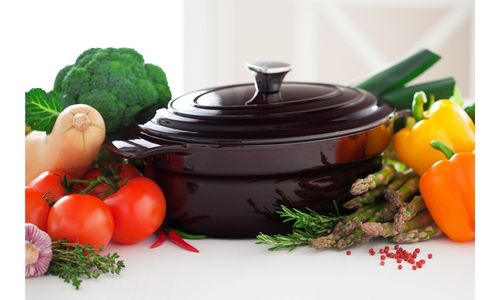
Cast iron is known to be one of the strongest metals that are universally used in many kitchens. The fact is, cast iron helps in searing the food well. It also adds a peculiar caramelized flavor and helps cook the food evenly.
The best part is that cast iron can withstand high temperatures, so you can use it for long hours of cooking, and it won’t be affected. You only need to be careful of the manufacturing standards and whether the cast iron vessel is made using other different types of metals or not.
For e.g., enameled cast iron pots are much better than regular ones and are made to withstand and conduct better heat. If they are coated with non-stick material, you may want to think twice before tossing them into the oven.
Most iron pans these days have it mentioned at the bottom of the pan if they are oven safe, or you can always check with the manufacturer.
Advantages:
- Simple looks with minimal designs or coatings
- Can withstand high temperatures
- Enamelled cast iron does not rust easily
- Totally safe for oven use
Disadvantages:
- Heavy
- May disrupt your oven if they are not enameled or are of poor quality
- Non-enameled pans cant handle acidic foods
- Not dishwasher safe or soap friendly, maintenance issues
Stainless Steel Pots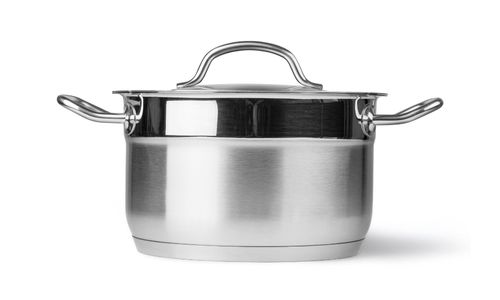
Stainless steel pots are also made to withstand high temperatures, just like cast iron pots. However, there are a few things you need to take care of with stainless steel pots. First, they do not offer even heating and heat distribution. Therefore, you may see some uneven cooking across your meals.
Second is the brand quality that you need to make sure of. Only if the manufacturer mentions that the pot is oven safe or if it’s labeled oven safe, then would it be advisable to toss it into the oven. Looking at the properties of stainless steel, it is durable to resist high temperatures and, therefore, can safely be used in the oven.
Advantages:
- Can withstand high temperatures
- Lightweight and easy to handle
- Dishwasher-safe and soap friendly
- Durable
Disadvantages:
- Does not provide even heat distribution
- It is not non-stick; therefore, bits of food may stick at the bottom of the pan, making it difficult to clean.
Aluminum Pots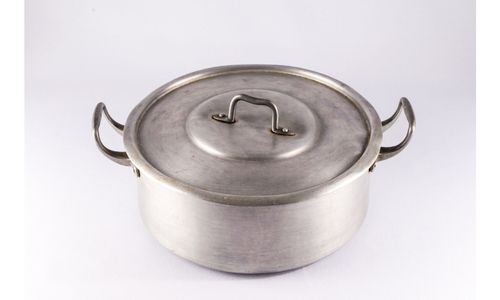
Aluminum pots are everything that you are looking for. They are easy to handle and maintain, lightweight, can withstand high temperatures, and extremely durable. Therefore, they are a perfect fit for use in the oven.
Of course, they don’t offer the kind of cooking and food searing you would find in cast iron, but it serves the purpose. Additionally, certain aluminum pots are also non-stick, so it’s a win-win. Before using an aluminum pot for cooking, you must be careful of two things:
First is the manufacturing quality and if there is any mixture of metals used while making the pot. The second would be to check any plastic labels or handles on the pot before tossing it into the oven.
Otherwise, we would recommend aluminum pots for cooking in the oven any day. Food may take longer to cook in an aluminum pot as it is a good conductor of heat but does not retain heat like cast iron or stainless steel.
Disadvantages:
- Not dishwasher safe
- Aluminum may leach into food with high temperatures unsuitable for acidic foods.
- Quality issues as it may not be pure aluminum, and hence spoil the oven.
Copper Pots
Copper is a highly reactive metal. Therefore, one should be extra careful before using it in the oven. Of course, it is safe to go in the oven, but the copper pot is usually made by mixing other metals to reduce its reactivity.
The mixture of other metals increases the manufacturing cost and, therefore, increases the overall cost of the vessel. Copper is an expensive metal and an excellent conductor of heat and electricity. Mixing other metals makes it less reactive and durable, but one needs to ensure the quality.
Therefore, your food will cook up faster than expected. One has to keep monitoring their food in the oven before using a copper pot. So, unlike other pots, copper pots will not require preheating in the oven as it heats up rather quickly.
Advantages:
- Good conductor of heat; hence food cooks up faster
- Copper also adds a great flavor and taste to food
- Durable and can withstand high temperatures
Disadvantages:
- Not suitable for acidic foods at high temperatures as metal can leach into food. For people allergic to copper, this may be unsafe.
- Need to monitor the cooking due to high reactivity constantly
- Copper is not dishwasher safe.
- Heavy and expensive compared to other types of pots
Glass pots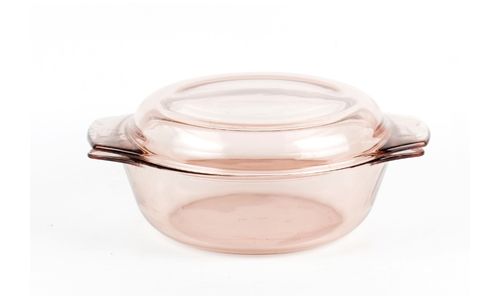
Glass pots may be difficult to handle, but they are oven safe when thick and built of good quality glassware. You don’t have to worry about transferring your food from one pot to another vessel and can directly toss the pot in for cooking as well as serving food.
Glass is made to resist high temperatures and is known to be suitable for oven or microwave use. Just make sure not to use any plastic lids on top and check if it does not have any plastic stickers or labels on the surface.
Glass pots that are suitable for oven use are usually expensive but worth the price if handled with care. Just check with the manufacturer if the glass pot is meant for oven use before tossing it into the oven.
Non-Stick Coated Pots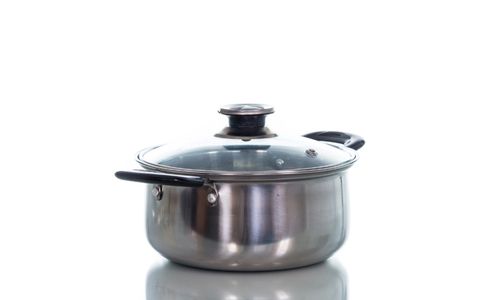
Non-stick coated pots can surely be used in an oven. However, the quality of the coating holds significant importance here. After reaching a certain temperature, the non-stick coating should not start wearing off.
Usually, non-stick pans are made of heavy-duty metals like iron or steel. It is only because they tend to stick food on their surface is why manufacturers opt for a non-stick coating over them. The coatings are usually oven friendly, but sometimes they may get reactive with food at higher temperatures.
The best you can do is, check the label or check with the manufacturer if the pot is oven friendly. They are usually labeled as oven-safe below the surface of the pot. We would still personally recommend you opt for non-coated versions, but if you have a coated pot at home, you can use it in the oven, for sure!
Advantages:
- Does not allow food to stick to the surface
- Easier to maintain and clean
Disadvantages:
- The coating may wear off if not of good quality
- Certain coatings cannot resist high temperatures and can leach into food, which may be harmful
Pots to not put in the oven
Wooden Pots
This is needless to say. You cannot use wooden pots in an oven. Even if it’s a pot made of wood and metal mixture, putting it in the oven is still a bad idea.
Firstly, the oven is not meant to put wooden pots or utensils. Secondly, the wooden pot will start bending and go out of shape due to extreme temperatures.
The dish may get a strong wooden flavor, but you will end up spoiling your oven or spoiling the wooden pot. Either way, you are at a loss, so it’s best to avoid wooden pots for oven use.
Plastic Containers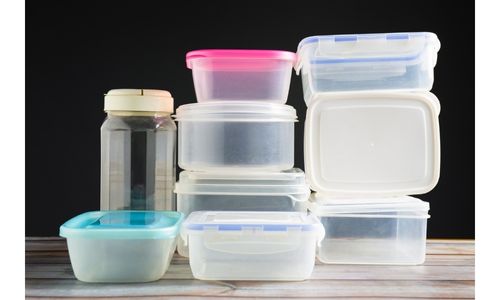
Plastic containers are a strict no when using them in the oven. Plastic cannot sustain high temperatures at all, so it will start melting. The chemicals in the plastic can be harmful and spoil your oven and the food inside.
Certain plastic bowls and pots claim that they are microwave safe and can be considered for heating. However, please do not use them in the oven strictly because the oven releases high heat for cooking and can damage the plastic.
Plastic, in general, is harmful to the environment, so maybe avoid using it altogether, right? We strongly suggest you keep plastic pots away from the oven or microwave too!
Clay Pots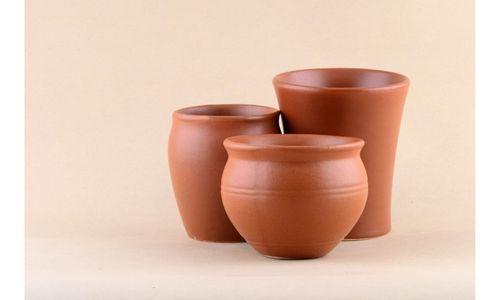
Since an oven uses extremely high temperatures for cooking, clay pots may crack down due to such high temperatures. Clay pots are used globally in several regions and impart a very earthy flavor to the food, enhancing the overall taste.
However, using them in an oven will only cause damage to the device as well as the pot in total. This is why be it clay or any pot using clay as a mixture, avoid using them in the oven for safety reasons.
What can I use instead of pots in the oven?
After reading the article, you must be wondering, what can I use in an oven if not any pots? So after doing some research and asking a few chefs and cooking experts, there are two alternatives you can opt for, either a stock pot or a dutch oven!
Both are oven safe, but dutch ovens are preferable over a stock pot for oven use. Here is why!
Stock pots
Stock pots can be made of any metal, be it aluminum, steel, copper, cast iron, etc. However, they are made to hold broths and liquids. Therefore, the bottom base is very thin. The thin base ensures that the food inside the stock pot cooks up rapidly.
Therefore, stock pots are more suitable for use on the stovetop or hob. If they tend to heat up rapidly, the high temperature in the oven would require you to constantly monitor the stock pot to prevent overheating or damage.
Dutch Ovens
Dutch Ovens are thicker and more durable as compared to stock pots. They have a thicker base to sustain high temperatures and more cooking time. They are also called casseroles, as they are deeper in structure, which means they can hold more quantities of food.
Dutch ovens can be used for cooking and storing food due to their high capacity. And they, too, are made of cast iron or stainless steel. They are usually quite raw in form and can sustain high temperatures, making them suitable for oven use.
We encourage you to use stock pots and dutch ovens for oven use. However, dutch ovens are better for longer cooking periods because they are thicker and more durable. On the other hand, stock pots should be more versatile and be made of better quality metal if you want to use them for cooking in an oven.
So when it comes to choosing between two dutch ovens over stock pots, any day!
Dutch ovens are always safer for oven use, but stock pots are not necessarily safe for oven use!
Factors to consider before using a pot in the oven
Using a pot in the oven is definitely easier than using multiple oven-safe vessels. But there are certain factors you need to consider before you toss a pot directly into the oven. If you are unsure what to look for, we have listed a few factors to keep in mind.
Check the label for oven safety.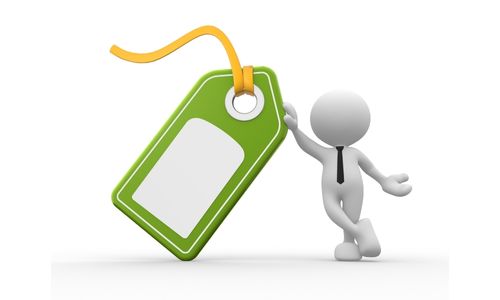
Usually, oven-safe pots have a label engraved or printed over their surface if they are safe for oven use. You can always contact the manufacturer if you don’t find the label. And if none of them is possible, then we would suggest not using them in the oven!
It is always better to confirm with the manufacturer because each brand and oven pot has its specifications. Some may be able to sustain little heat, while some pots may not be safe for oven use at all.
Therefore, it is always better to take precautions before tossing your pot into the oven.
Beware of any plastic or wooden parts.
If the oven pot you are considering is made of pure metal or the materials mentioned above are safe, you can use it without worry or fear! However, if the pot has any plastic, wooden, or rubber attachments, or even a plastic sticker, you must not use it in the oven.
Plastic stickers or paper stickers are washable and can be easily removed. Just check for any extra attachments in particular and the material they are made of!
Coating or color on the material
If the oven pot has any chemical coating over the metal, check twice before putting it in the oven. Some coatings may come off due to excessive oven heat and leach into the food. This can make your food unsafe.
Certain pots have a non-stick coating over their surface, which may be safe for oven use. However, you need to check the label on the vessel or with the manufacturer before using it for oven cooking.
Brand and Quality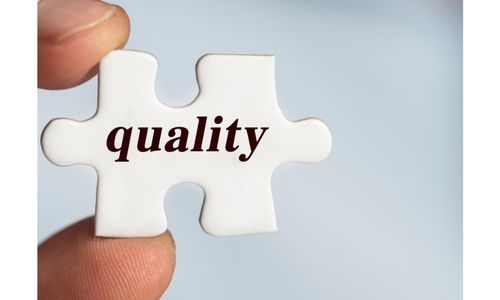
If you purchase an oven pot from a well-versed and good-quality brand, then you are assured of the safety before oven use. If the brand is known for making oven-safe pots, then you can always refer to the label and use it accordingly.
Good quality brands consider all factors before manufacturing their vessels and ensure consumer safety.
A good quality oven pot will also last longer and sustain higher temperatures at a better rate than other kinds of oven pots.
FAQs
Can you use any oven when cooking in a pot?
No! Oven-safe pots are not necessarily microwave-safe as well. Microwave ovens function very differently compared to convection or regular ovens. Even if you use the microwave oven, you cannot necessarily use oven-safe pots in that mode.
You only need to use specific types of cookware and pots after checking whether it’s oven and microwave safe. Otherwise, it can damage your microwave and lead to fire, sparks, and even accidents.
Are ceramic pots safe for oven use?
Yes! Ceramics, in general, can sustain high temperatures. However, it is always best to check the label or manufacturer’s instructions before you use a ceramic pot in the oven. Certain poor-quality ceramic pots may not be able to withstand high temperatures in the oven.
This is why you need to read the instructions carefully before using a ceramic pot for oven cooking.
Can you put a pot in the oven with a lid on?
Depends! If the lid is made of oven-safe material like steel, aluminum, or cast iron, then you can use the lid. Even glass lids are safe for oven use. However, if the lid is made of plastic, wood, or any other material that is rendered unsafe for oven use, you must avoid using a lid.
Can I use a pot for “baking” in the oven?
Yes! You can use a pot for baking in the oven. Generally, we recommend cast iron pots as they offer even heating and can resist extreme oven temperatures.
Conclusion
It has always been a matter of controversy when choosing the best cookware for oven use. But, about stock pots going in the oven, not many of us might know that they are oven safe.
Our article above gives a very detailed description of what types of pots are safe for oven use. The best-recommended type is cast iron, or aluminum, and even stainless steel or glass. They can sustain high temperatures and are safe for oven use.
Read our article above and tell us which type of pot you would prefer to use in the oven through the comments section below. Until then, happy and safe cooking!
